|
|
 |
|
Calanoida ( Order ) |
|
|
|
Clausocalanoidea ( Superfamily ) |
|
|
|
Scolecitrichidae ( Family ) |
|
|
|
Scottocalanus ( Genus ) |
|
|
| |
Scottocalanus thori With, 1915 (F,M) | |
| | | | | | | Syn.: | S. helenae : A. Scott, 1909 (p.111, figs.M); Sewell, 1929 (p.183); Mori, 1937 (1964) (p.49); Sewell, 1947 (p.143, Rem.); C.B. Wilson, 1950 (p.338, M, no F); ? Chiba, 1956 (p.54); Shih & Chiu, 1998 (p.538);
? S. persecans : Sars, 1925 (p.157, figs.F,M, Rem); ? Jespersen, 1940 (p.35); Wilson, 1932 a (p.80); Brodsky, 1950 (1967) (p.241, figs.F,M);
? S. terranovae Farran, 1929 (p.252, M only) | | | | Ref.: | | | With, 1915 (p.215, figs.F,M); Farran, 1926 (p.266); Tanaka, 1961 a (p.140, Rem.); Vervoort, 1965 (p.56, Rem.: p.54); Morris, 1970 (p.2301, 2312, figs.F, Rem.); Park, 1983 (p.198, 208, Redescr. F, figs.F, Rem., as thorii); Bradford & al., 1983 (p.116, 120, Rem., figs.F,M); Roe, 1984 (p.357); Mulyadi, 1998 a (p.393, Redescr.M, figs.M, Rem.: p.396); Mulyadi, 2004 (p.36, figs.M, Rem.); Vives & Shmeleva, 2007 (p.812, figs.F,M, Rem.) |  issued from : Mulyadi in The Raffles Bull. Zool., 1998, 46 (2). [p.395, Fig.9]. Male (Flores Sea): a, habitus (dorsal); b, forehead (right lateral side); c, last thoracic segment and urosome (right lateral side); d, rostrum (frontal view); e, P2; f, P3; g, P5; h, distal segment of left P5.
|
 Issued from : J.M. Bradford, L. Haakonssen & J.B. Jillett in Mem. N. Z. oceanogr. Inst., 1983, 90. [p.121, Fig.75]. Female: A, habitus (lateral right side); B, genital segment (dorsal); C, genital segment and P5 (lateral left side); D, rostrum; E, endopod of P2; F, P5. Male: G, habitus (lateral left side); H, P5; I, terminal part of left P5 exopod. Diagnosis from Bradford, Haakonssen & Jillett (1983, p.120), and Vives & Shmeleva (2007, p.812) : Female : - Head with with triangular crest, but less salient and more rounded than in S. helenae. - Rostral projections shorter excavation with very short, blunt points. - Prosome 4.5 times length of urosome. - Posterolateral corners of last thoracic segment triangularly produced but obtusely rounded. - Urosome 4-segmented. - Genital segment symmetrical, moderately swollen ventrally, as long as following three urosomal segments. - A1 24-segmented, reaching distal end of urosomal segment 3 [or more ]. - P5 with 3 indistinct segments, distal segment with small apical conical process bearing short spine and long sub-apical spine with rudimentary hair at its base ; long spine extends to end of urosomal segment 3. Male : - Rostrum more slender than in female. - Posterior of urosomal segments 2-4 serrated. - A1 extends to urosomal segment 4. - P5 distinctly longer than urosome. Right leg endopod extends well beyond exopodal segment 1 ; exopod segment 1 with several projections medially, terminally produced inwards, exopod segment 2 curved, segment 3 short and pointed. Left leg endopod extends beyond exopodal segment 1, with indication of segmentation ; exopod 2-segmented, distal segment terminates in 2 or 3 leaf-like structure including slender hook-shaped organ with terminal setae and plate with at least 7 serrations.
|
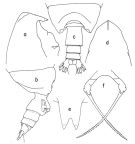 issued from : T. Park in Antarct. Res. Ser. Washington, 1983, 38 (3). [p.209, Fig.25]. Female: a, forehead (lateral); b, last thoracic segments and urosome (lateral right side); c, idem (dorsal); d, anterior part of head (dorsal); e, rostrum (anterior); f, P5 (anterior). Nota: Cephalosome and 1st metasomal segment fused, 4th and 5th separate on dorsal side. Urosome about 19/100 length of prosome. A1 extending beyond distal end of metasome by its last 4 segments. All cephalosomal appendages and first 4 pairs of legs agree in anatomical details with those of .
|
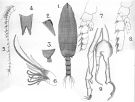 issued from : A. Scott in Siboga-Expedition, 1909, XIX a. [Plate XXVII, Figs.1-9]. As Scottocalanus helenae. Male (from Halmahera Sea): 1, habitus (dorsal); 2, forehead (lateral); 3, last thoracic and genital segments (left side); 4, rostrum; 5, A1; 6, Mx2 (distal portion); 7, P2; 8, P4; 9, P5.
|
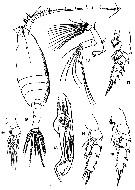 issued from : T. Mori in The pelagic Copepoda from the neighbouring waters of Japan, 1937 (2nd edit., 1964). [Pl.23, Figs.9-15]. As Scottocalanus helenae.
Male: 9, habitus (dorsal); 10, A2; 11, P2 (posterior); 12, P1; 13, P5 (anterior); 14, P4; 15, P3 (posterior).
|
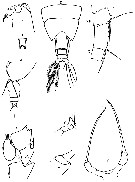 issued from : C. With in The Danish Ingolf-Expedition, Copepoda I, 1915, III, 4. [p.216, Text-fig. 68]. As Scaphocalanus thorii. Female (from 51°32'N, 12°03'W): a, forehead (lateral); b, rostrum; c, last two thoracic segments and urosome (dorsal); d, last thoracic segment with P5 and urosome (left lateral); e, segments 8-10 of A1; f, basis, endopod and exopodal segments 1, 2 of left P2 (anterior view); g, P5 (anterior view); h, base of spine (posterior view); i, base of spine (partly anterior view).
|
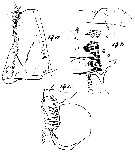 issued from : C. With in The Danish Ingolf-Expedition, Copepoda I, 1915, III, 4. [Pl. VI, 14 a-c]. As Scaphocalanus thorii. Female: a, labrum (anterior view); b, same (oral view); c, lamina labialis and serrula 6-dentata.
|
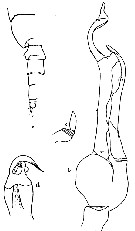 issued from : C. With in The Danish Ingolf-Expedition, Copepoda I, 1915, III, 4. [p.217, Text-fig. 69]. As Scaphocalanus thorii. Male: a, last thoracic segment and urosome (dorsal); b, right P5 (from the left and partly from below); c, exopodal segment 3 of right P5 (from below); d, left P5 (exopodal segment 3 from the right side).
|
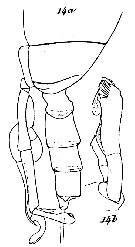 issued from : C. With in The Danish Ingolf-Expedition, Copepoda I, 1915, III, 4. [Pl. VIII, Fig. 14 a, b]. As Scaphocalanus thorii. Male: a, last thoracic segment with P5 and urosome (left lateral); b, left P5.
|
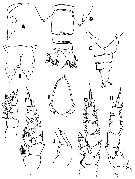 issued from : B. Morris in J. Fish. Res. Bd Canada, 1970, 27 (12). [p.2313, Fig.8]. Female (from subtropical central North Pacific): A, forehead (lateral); B, rostrum (anterior); C-D, posterior prosome and urosome (lateral and dorsal, respectively); E, P1 (anterior); F, P2 (anterior); G, P3 (anterior); H, P4 (anterior); I, P5; J, distal segments of left P5. Nota: Body of rich brown color. Prosome to urosome ratio 45: 10. General shape as in S. helenae but cephalic crest more rounded. Rostral plate width (at base) to length (from base to tips of points) in ratio of 10 : 11. Rostral poins occupying 0.5 depth of depression. Lateral margins of rostral plates slightly inflated. A1 24-segmented. 5th thoracic segment (in lateral view) produced into bluntly triangular corners and emarginate below. Corners (in dorsal view) triangularly produced with small, knoblike tips. Urosome 4-segmented. Proportional lengths of urosomal segments and caudal rami 68 : 27 : 23 : 10 : 35. Genital segment symmetrical with moderate ventral swelling. Urosome segments without teeth along distal margins. P2 and P3-P4 with distinctive spinulation on anterior surface of exopodite and endopodite. Exopodite of P4 without anterior spinulation. P5 with 1 free segment on each side. Apical spine short and triangular, and with a small spinule at its base. Outer spine long and haired along distal half. Small spinule near base of outer spine. Rem.: With (1915) and Sars (1925, as S. persecans describe and illustrate this specis, but they differ in certain details. The posterior corners of prosome are more produced in With’s females and the long outer spine of the P5 extends almost to the distal margin of the 2nd urosomal segment, whereas in Sars’s specimens this spine does not reach the anterior margin of the urosomal segment 2.
|
 issued from : B. Morris in J. Fish. Res. Bd Canada, 1970, 27 (12). [p.2314]. Female: Proportional lengths of A1 segments.
|
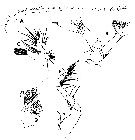 issued from : B. Morris in J. Fish. Res. Bd Canada, 1970, 27 (12). [p.2315, Fig.9, A-E]. Female: A, A1; B, A2; C, Mx1; D, Mx2; E, Mxp. Nota: A2 : exopod :endopod ratio of 13 : 10. Endopod bimerous with 2 setae on inner distal margin of endopod segment 1 and with 6 and 8 setae on outer and inner lobes of endopod segment 2. Exopod 7-segmented, with 1 lateral seta on each of exopod segments 2-6 and 3 terminal setae. Mx1 with 10 spines on gnathobase, 2 setae each on inner lobe 1 and 2, 5 setae on basipodite 2, 7 on endopod, 9 on outer lobe, and 6 on exopod. Mx2 with 4 setae on inner lobe 1, 3 on inner lobes 2, 3 and 4, a long strong spine on inner lobe 5, and 6 long, slender sensory appendages on endopod. Mxp as in S. helenae but apparently with only 2 setae plus 1 sensory appendage on proximal of basipod 1.
| | | | | Compl. Ref.: | | | Roe, 1972 (p.277, tabl.1, tabl.2); Vives, 1982 (p.292); Razouls & al., 2000 (p.343, Appendix); Park & Ferrari, 2009 (p.143, table 5, Appendix 1, as thorii, biogeography) | | | | NZ: | 8 | | |
|
Distribution map of Scottocalanus thori by geographical zones
|
| | | | | | | | | | Loc: | | | sub-Antarct. (S Australia), Canary Is., off W Cabo Finisterre, Bay of Biscay, Strait of Denmark, off S Iceland, Faroe Is., Maldive Is., Indian, Flores Sea, Philippines, off NE Taiwan, ? Japan, ? N Pacif., off N Hawaii, New Zealand, Chile | | | | N: | 13 | | | | Lg.: | | | (5) M: 4,9; (6) F: 5; (7) F: 4,69; M: 5,24; (9) F: 4,8-4,69; M: 5,3-5,24; (38) F: 5,76; (92) F: 4,73-4,47; (199) F: 4,8-4,41; M: 5,28-4,7; (777) M: 4,55-4,51; (1122) M: 4,52; {F: 4,41-5,76; M: 4,51-5,30} | | | | Rem.: | Meso-bathypelagic.
Sampling depth (sub-Antarct.) : 0-1200 m.
This species seems to have been confused with S. persecans and S. helenae by various authors (see synonymies in Vervoort, 1965). After Vervoort, a comparison of A. Scott's and Mori's S. helenae with With's S. thori shows that the species are identical; the species has been decribed as S. persecans by Sars (1925) and Brodsky (1950); Wilson's '1932) description and figures of S. helenae probably also refer to S. thori; it seems clear that Wilson (1950, p.338) described the male of S. thori as S. helenae, but the female attributed to that species is neither S. helenae nor S. thori as it has pointed lateral thoracic margins; it may be the same species as that described by Tanaka as S. helenae. Farran's (1929, p.251);S. terranovae from surface haulsoff New Zealand seems to be a composite species; the male cannot possible be separatd from S. thori; the female, tough it shows affinities with the latter species, represents a species different from S. thori and xhich should stand as S. terranovae. Vervoort does not include Tanaka's (1953, p.132; 1961, p.140) S. helenae into the synonymy of S. thori; it appears that females shows pointed lateral thoracic margins (rounded in S. thori), whilst the structure of P5 in male differs slightly. Park questions the validity of certain synonymies. The geographical distribution can't be given accurately.
For Bradford & al; (1983, p.122) this species is very like S. terranovae, S. farrani and S. helenae.
According to Park (1983, p.210), Vervoort (1965) considered the following species as synonymous: 1- The male of S. helenae as described by Scott (1909), Mori (1937), and C.B. Wilson (1950); 2- The male of Scottocalanus terranovae described by Farran (1929); 3- The female and male of Scottocalanus persecans as described by Sars (1925) and C.B. Wilson (1932). However, it seems to be almost impossible to establish their identities on the basis of descriptions and illustraytions given by these authors.
For Park (1983) the identification of S. thori is based mainly on the presence of a small notch on the distal end of the metasome, habitus, and shape of P5, however in the two specimens from 45°55'S, 132°33'E and 117°E, the distal end of the metasome in lateral view are broadly rounded, while With (1915) described it as somewhat triangulary prodiuced with an obtusely rounded distal end; also the distal rostral processes are slightly divergent instead of being straight. | | | Last update : 06/03/2017 | |
|
|
 Any use of this site for a publication will be mentioned with the following reference : Any use of this site for a publication will be mentioned with the following reference :
Razouls C., Desreumaux N., Kouwenberg J. and de Bovée F., 2005-2025. - Biodiversity of Marine Planktonic Copepods (morphology, geographical distribution and biological data). Sorbonne University, CNRS. Available at http://copepodes.obs-banyuls.fr/en [Accessed November 30, 2025] © copyright 2005-2025 Sorbonne University, CNRS
|
|
 |
 |














